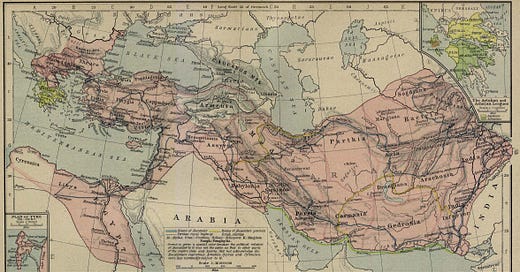The 5,000-Year War in the Middle East
This stunning realization from archaeologist Rupert Chapman needs to be heard.
The 5,000-Year War
Rupert L. Chapman III, Ph.D. a retired archaeologist and British Museum curator of Levantine Antiquities.
The first war in recorded history, going back some 5,000 years, was a war between the Sumerians and the Elamites. This wasn't the first war, mind you, just the first one for which we have a contemporary written record we can read. The Sumerians lived in what is now southern Iraq; the Elamites, in what is now southern Iran. From that time onwards there has been war between the populations in these two regions.
Then there is the conflict between the Sumerians and the Akkadians. The Akkadians were Semites—that is, they spoke a Semitic language related to Hebrew and Arabic—who lived in central Iraq. The Akkadians also waged war on the Assyrians, who lived in northern Iraq. The Sumerians and the Akkadians were replaced by the Babylonians, and the war between the Babylonians in southern Iraq and the Assyrians in northern Iraq was only ever interrupted by the incursions of the Gutians, a warlike mountain people from what is now Kurdistan. The Gutians were later replaced in Kurdistan by the Kassites, who also overran and conquered Iraq, and then by the Kurds, of course.
Returning to the Early Bronze Age, archaeology has shown that the Sumerians sent conquering forces up the Euphrates into what is now northern Syria, which they ruled for several hundred years. The people of northern Syria, the Amorites, fought back and expelled the Sumerians, establishing their own independent city-state—but these never formed a unified kingdom. Of these, the two most powerful were always Damascus and Aleppo, which were great rivals.
Inland in Syria there was a separate material culture with its own languages—Amorite in the Bronze Age and Aramaean in the Iron Age. On the coast, there was yet another cultural and linguistic regional group, the northern extension of the Canaanite region further south. Those there spoke the Canaanite language, which was the direct ancestor of the Hebrew language that emerged in the Iron Age. This extension was what is now Lebanon. It “enjoyed” a precarious independence and was the commercial entrepot connecting the Mediterranean world to the Mesopotamian world and points further east.
At the southern end of the Fertile Crescent was a Canaanite region composed of small, independent city-states that competed with each other, with the northern extension, and with Damascus. At the same time, the Canaanites west of the River Jordan fought with those east of the river. Canaan itself was sometimes independent and sometimes part of the Egyptian Empire in the Bronze Age. In the Iron Age, after a brief period of independence as the Kingdoms of Israel and Judaea, Canaan became the border zone and battleground for the northern and eastern empires of Assyria and Babylon, Iran, and the Seleukid Greeks—and, at times, for the Ptolemaic Greeks of Egypt. These empires were followed by the other, later, empires with which you will be familiar.
What emerges from all of this is that ALL the regional conflicts of the present-day Middle East have been going on for the last 5,000 years. In that time, the languages have changed, the ethnicities have changed, and the religions have changed—and yet the conflicts have continued. What this tells us is that the excuses given for the present-day conflicts—religious, political, and ethnic—are merely that: excuses, not explanations. They tell us nothing whatsoever about the causes.
I have called this The 5,000-Year War.





Ah, I thought I'd heard this before. Thanks so much for providing the original reference. Desmond ... If anybody did incredibly well under terrible circumstances, it was he.
The history of the Near East is truly fascinating. Good article.